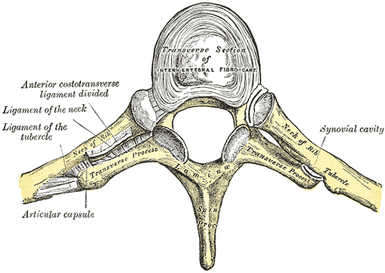The word, "stenosis" automatically implies that you are dealing with a tube or canal. Stenosis simply means that this tube or canal, for whatever reason, is getting smaller. Thus, Spinal Stenosis is the name given to the condition of calcium deposition involving the spinal bones and ligaments that affect (shrink / compress) the Spinal Canal.
Notice where the Spinal Canal is Smaller
Now, look at the big hole in the middle ---- just (behind) the disc? This is the Spinal Canal (sometimes called the Central Canal). When you stack the 24 spinal vertebrae on top of each other, all of these large "holes" line up with each other to create a long tube. This tube (the Spinal Canal) is where the Spinal Cord is housed.
Believe it or not, in the United States, one of the most common reasons for Spinal Surgeries in the over-60 crowd is Spinal Stenosis of the lumbar spine (low back). Current estimates by the American Association of Neurological Surgeons (AANS) put the number of elderly suffering with Spinal Stenosis at almost half a million people and growing rapidly. Right now nearly one in five Americans is over 60 ---- so the number of people struggling with Spinal Stenosis will continue to grow as our population ages and gets increasingly heavier.
SPINAL STENOSIS DEFINITION:
According to the most common definition, published in a 1976 issue of the medical journal Clinical Orthopedics, Spinal Stenosis of the low back is caused by narrowing of the Central Canal. This causes nerves to be pinched, which leads to unrelenting buttock pain pain, limping, lack of sensation in the legs, altered sensation in the legs, numbness, tingling, diminished strength, and decreased physical activity. Although there are several types of Spinal Stenosis, there is only one that we will deal with here, as it is the one that responds to Spinal Decompression Therapy.
DEGENERATIVE SPINAL STENOSIS:
By far, the most common type of Spinal Stenosis is Degenerative Stenosis. The truth is, if you live long enough, you will probably end up with at least a small degree of Degenerative Spinal Stenosis. It is a degenerative narrowing of the Spinal Canal (Central Canal) and nerve root canals (Intervertebral Foramen). And in similar fashion to DEGENERATIVE DISCS, is characterized by bone and ligament calcification / thickening in the spine. This calcification results thickening of supporting ligaments, which cause a subsequent narrowing of the Central Canal. As you might imagine, this causes compression of spinal nerves and nerve roots ----- and sometimes, even the Spinal Cord itself. All of this creates the "Perfect Storm" that can cause the myriad of symptoms that we discussed in the previous paragraph.
WHAT CAUSES DEGENERATIVE SPINAL STENOSIS?
Degenerative changes in the vertebrae and surrounding spinal structures (ligaments, discs, tendons, bones, cartilage, etc) is affected by age. However, if you read the piece on DISC DEGENERATION, you are already aware that age is often times an all too convenient scape goat. The biggest reason people get Spinal Stenosis is mechanical dysfunction over time.
As the body weakens and dehydrates with age and / or injury, bones and ligaments hypertrophy (they "thicken" or get slightly bigger). This is due to a buildup of calcium deposits as the body tries to stabilize itself. However, despite this hypertrophy, the bones themselves become less dense (osteoporosis) and the discs of the spine can lose their height as well as their fluid.
The discs compress, causing tilting, slippage and rotation of vertebral bodies (SUBLUXATION). This results in compression of the pain-sensitive thecal sac that surrounds the Spinal Cord. It can also cause compression of the Spinal Nerves as well. In some cases, bone spurs form in the Intervertebral Foramen (Foraminal Stenosis). This can cause compression of Spinal Nerve Roots as they exit through the Intervertebral Foramen and travel through the lower back, buttock, and down the legs. This typically leads to chronic low back pain and intermittent numbness and weakness in the legs (SCIATICA SYMPTOMS).
CALCIFICATION OF LIGAMENTUM FLAVUM:
If you have ever had a chance to look at a spine taken from a cadaver, you will notice a huge difference from the model spines seen in doctor's offices or science classrooms. Model skeletons or model spines show you the bones only. While this is great for learning anatomy, it does not give one a very lifelike picture of what the spine actually looks like or how it really functions.
To say that the spine is held together with ligaments is a gross understatement. The spine is literally "mummified" in ligaments ---- inside and out! Yes, interestingly enough, some of these ligaments are on the inside of the Spinal Canal. The ligament that runs the entire length of the back part of the Spinal Canal is called Ligamentum Flavum, while the ligament that runs the entire length of the front of the Spinal Canal (against the vertebrate and discs) is called the Posterior Longitudinal Ligament. Simply understand that the Spinal Cord sits in the Spinal Canal, but never touches the bones or discs. It touches these and other ligaments.
Hypertrophy, thickening, and calcification of these spinal ligaments (particularly the Ligamentum Flavum) can reduce the space available to the Spinal Cord and Spinal Nerves. Ligaments tend to stiffen with age and injury, and can "buckle" into the Central Canal. This creates additional areas of compression and pain. Degenerative Arthritis (sometimes referred to as Degenerative Disc Disease (DDD), Degenerative Joint Disease (DJD) or DISC DEGENERATION) will often compound the problem by increasing the stiffness and inflexibility of the ligaments and joints. In addition, Spinal Discs tend to dehydrate with age. None of this is a good thing.
VIDEO
ON
SPINAL STENOSIS
If you are one of the nearly half a million Americans struggling with the painful and debilitating effects of Spinal Stenosis, I would urge you to call (417) 934-6337 and set up a free consultation with Dr. Schierling to FIND OUT WHETHER YOU ARE A CANDIDATE for Spinal Decompression Therapy.







 RSS Feed
RSS Feed
